Both Mr. TWS and I had looked forward to seeing the historic places of D-Day (June 6, 1944) in the Normandy region of France. These are the sites where the military forces of the United States, Great Britain, and Canada executed the largest amphibian invasion in history beginning their fight for the liberation of Western Europe in World War II. Although we’d heard much about how moving it is to visit these sites, we felt emotions even more deeply than expected. These are my top 5 recommendations for D-Day and Battle of Normandy sites to visit.
5 top D-Day and Battle of Normandy sites to visit
“Soldiers, Sailors and Airmen of the Allied Expeditionary Force. You are about to embark upon the Great Crusade, toward which we have striven these many months. The eyes of the world are upon you. The hopes and prayers of liberty-loving people everywhere march with you.”
— Dwight D. Eisenhower addressing the troops before the invasion of Normandy
Normandy American Cemetery
It’s a humbling experience to visit the Normandy American Cemetery, 172 acres of land in Colleville-sur-Mer granted the United States by France in perpetuity. The cemetery is located on the site of the original burial grounds established by the U.S. Army on June 8, 1944 to bury their dead. On a tip from another traveler, we made a point to be at the cemetery in time for the daily flag-lowering ceremony. As we watched, there was a gun salute, taps were played, and two military jets flew across the sky above us. The ceremony added a special dimension to the moving experience. (The ceremony took place at 4:00 pm when we visited in early October, but the time may vary in winter and summer.)
Quietly, we walked among many of the 9,385 marble markers of the graves of U.S. military who died during the D-Day invasion and the ensuing three months of the Battle of Normandy. We stepped from one memorial to the next, reading the inscriptions on the stones identifying the brave soldiers from all over the United States.
“These are the boys of Pointe du Hoc. These are the men who took the cliffs. These are the champions who helped free a continent. These are the heroes who helped end a war.” — President Ronald Reagan in Normandy to mark the 40th anniversary of D-Day, June 6, 1984
I am always particularly moved by monuments to the unknown soldiers of wars throughout time. The marker in the photo above is one of 307 that honor the unknown fallen soldiers of the Battle of Normandy. To the right in the photo above is a Star of David identifying a Jewish soldier. Stones on the marker are traditional tokens left by those paying respect.
A semicircular monument and reflecting pool occupy a prominent location adjacent to the grave sites. In the center of the memorial is a 22-ft. bronze statue, The Spirit of American Youth Rising from the Waves by Donald De Lue, that is dedicated to the soldiers who were not found or couldn’t be identified.
Omaha Beach
Filled with emotion, we stepped onto Omaha Beach in Vierville-sur-Mer, walking at low tide on the same wide expanse of sand that U.S. troops crossed on D-Day. Of the five D-Day beaches (Omaha, Gold, Juno, Sword, and Utah), Omaha Beach saw the greatest casualties with about 2,400 troops killed, wounded, or missing in action.
Les Braves (The Brave) sculpture was created by Anilore Banon (shown in the photo below) to represent three elements — The Wings of Hope; Rise, Freedom; and The Wings of Fraternity.
“It was unknowable then, but so much of the progress that would define the 20th century, on both sides of the Atlantic, came down to the battle for a slice of beach only six miles long and two miles wide.” — President Barack Obama at a ceremony at the American Cemetery in Normandy marking the 65th anniversary of the D-Day invasion.
Arromanches
Our first stop of the day was at the village of Arromanches, a key location for D-Day operations. Standing on the clifftop above the village, we took in the vistas of the English Channel and remnants of the concrete caissons that formed the Mulberries, the artificial harbors built by the allies to facilitate getting vehicles and equipment to the shore.
Looking in the opposite direction, we were able to view Gold Beach (shown in the photo below), one of the British landing beaches on D-Day. The British also landed at Sword Beach. In the photo, you can see a few of the concrete caissons to the left.
Arromanches 360
An attraction well-worth seeing here is Arromanches 360. This cliff top cinema presents “Normandy’s 100 Days”, an intense 19-minute film projected on 9 screens in a circular theater showing dramatic archive footage from American, Canadian, English, French, ad German collections.
Musée du Debarquement
In the village of Arromanches next to the port, is the Musée du Debarquement (D-Day Landing Museum), a museum with interesting and well-displayed models, photos, and exhibits relating to the construction of the Mulberry harbor.
Batterie Allemande de Longues-sur-Mer
Driving between Arromanches and Omaha Beach, we stopped near the village of Longues-sur-Mer where we explored Batterie Allemande de Longues-sur-Mer, a German gun battery consisting of four artillery casemates and one lookout bunker strategically positioned for their views of the English Channel and Allied forces. We walked around, on top, and inside the concrete batteries built into the landscape.
It’s chilling to stand inside a bunker next to a massive piece of artillery that had once been aimed at the Allies approaching on the channel.
Bayeux
Bayeux was spared destruction during World War II and was the first French town to be liberated by the allies on June 7, 1944. Convenient to the D-Day beaches, Bayeux is a good place to use as your base as you explore the area. There are also interesting attractions to see here, too.
Musée Memorial de la Bataille de Normandie
The Musée Memorial de la Bataille de Normandie (Memorial Museum of the Battle of Normandy) in Bayeux has a wide range of wartime gear of all kinds — uniforms, weapons, communications equipment, vehicles, and articles of the everyday existence of Allied and Axis soldiers. A film offered at the museum is a great introduction to the history of the D-Day invasion and liberation of Normandy. Nearby is the Bayeux War Cemetery with 4,848 graves of soldiers, mostly from the U.K. While in Bayeux, be sure to visit the Bayeux Tapestry (the famous 11th-century 68.3m long embroidered tapestry) and the Cathédrale Notre Dame (Cathedral of Our Lady).
Of course, there are several other significant D-Day and Normandy sites to visit, such as Utah Beach (the second important American D-Day landing point), as well as several other museums in tribute to the military, civilians, and events of the Battle of Normandy and liberation of France. But we feel that we were thoroughly immersed in history, tragedy, and victory of this period of World War I with the important sites we experienced.
“They fight not for the lust of conquest. They fight to end conquest. They fight to liberate.” — President Franklin D. Roosevelt, radio broadcast, June 6, 1944
Trip tips
Accommodation tip: We stayed in Bayeux at the Hotel Lion d’Or. It is said that this was General Eisenhower’s favorite hotel when staying in Bayeux. We had a nice meal at the restaurant here on our first night. Mr. TWS still raves about their signature apple dessert.
Dining in Bayeux tip: My favorite meal in Bayeux was at La Rapiere, a small restaurant serving wonderful regional dishes in a charming building on a side street off of Rue St. Jean.
Bayeux social tip: La Gitane on Rue St. Jean is a good place to stop in for a drink and friendly conversation with the locals after a day visiting the D-Day sites. It was just a few doors down from our hotel.
Lunch in Arromanches tip: The Hôtel de La Marine is a lovely location next to the beach for enjoying lunch outside on the terrace.
Car rental tip: We rented from Hertz car rental at the Total Access petrol station in Bayeux (and returned it a few days later in Brittany). A taxi ride from the hotel cost about 8 euros.
Normandy itinerary tip:
- We arrived in Bayeux in the mid-afternoon. After checking in to our hotel, we visited the Tapestry Museum, cathedral, and D-Day Museum, easily reaching each location on foot.
- After picking up the rental car the next morning, we first drove to Arromanches, visiting Arromanches 360 and the Musée du Debarquement followed by lunch in town.
- From there, we spent about one hour at the German artillery battery in Longues-sur-Mer.
- In order to be at the Normandy American Cemetery for the flag lowering at 4:00 pm, we went from Longues-sur-Mer directly to Omaha Beach, backtracking only a little to visit the cemetery afterwards.
- From the cemetery, we drove back to Bayeux by a different route through the beautiful countryside and small villages.
You may find that a different sequence and timing fits your needs better, but this worked well for us.

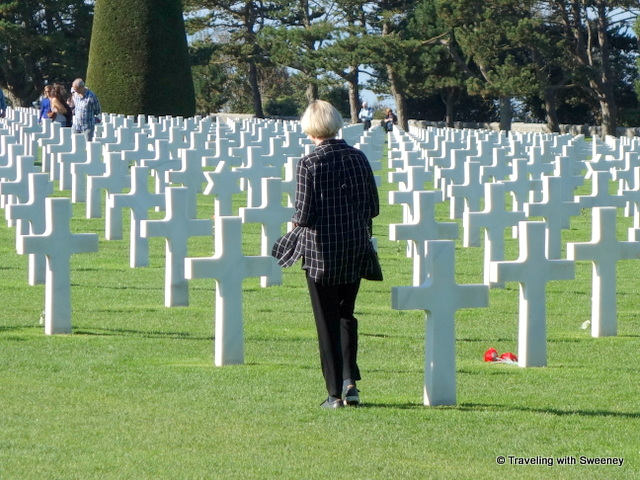
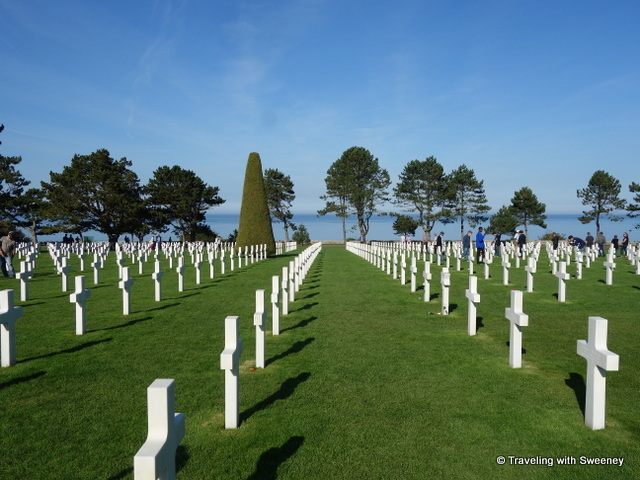
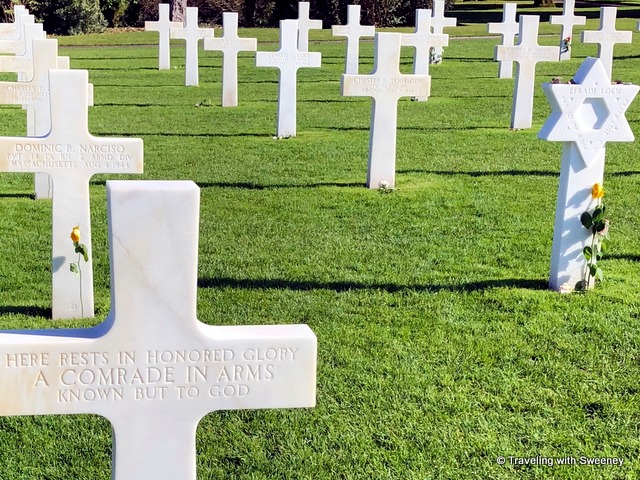
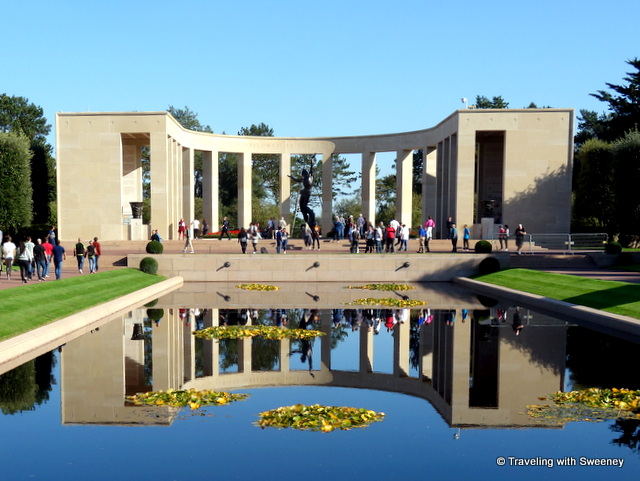
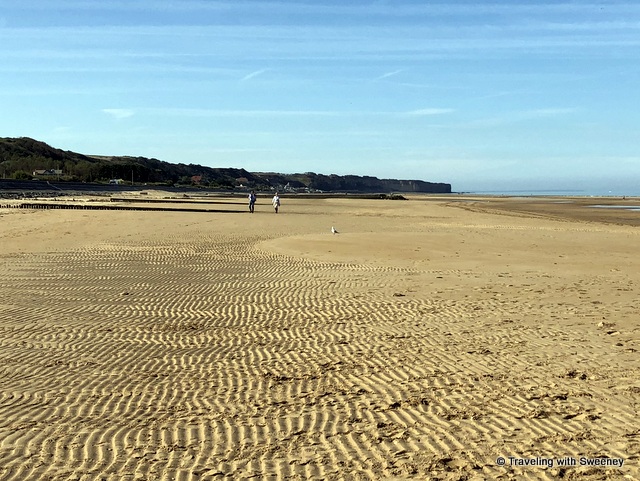


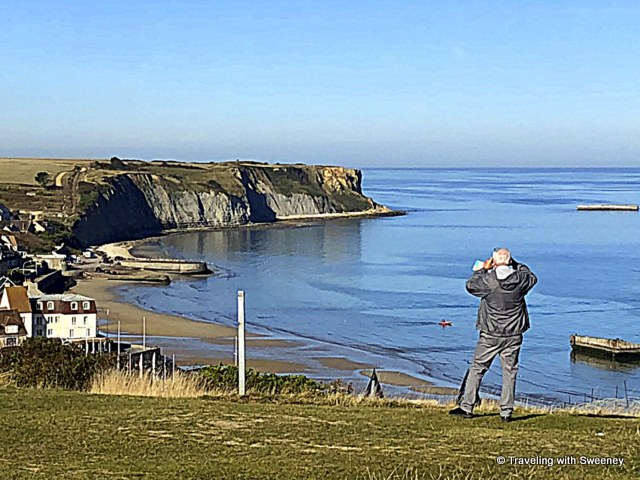
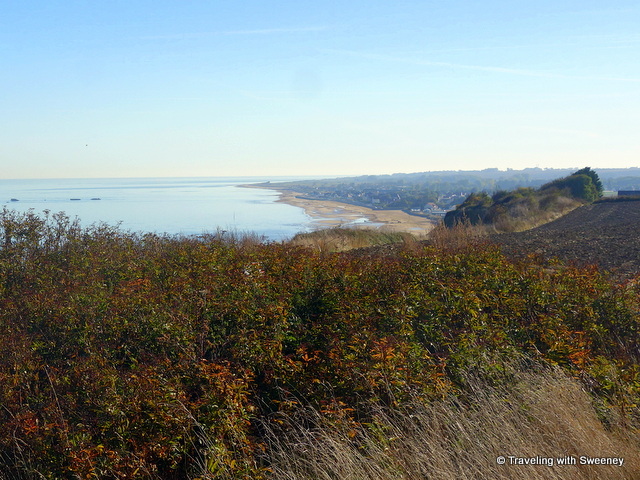
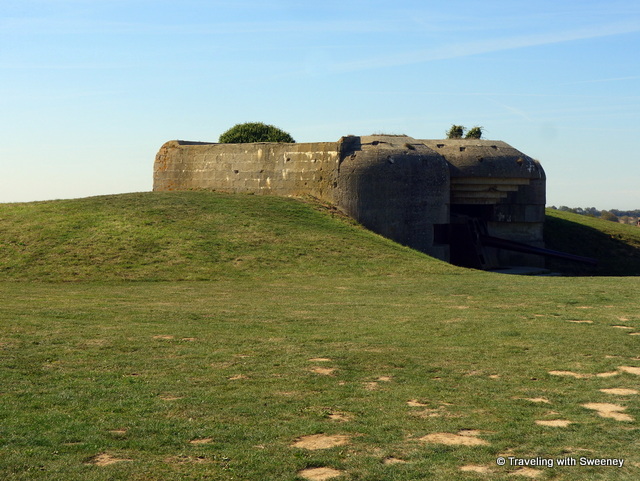
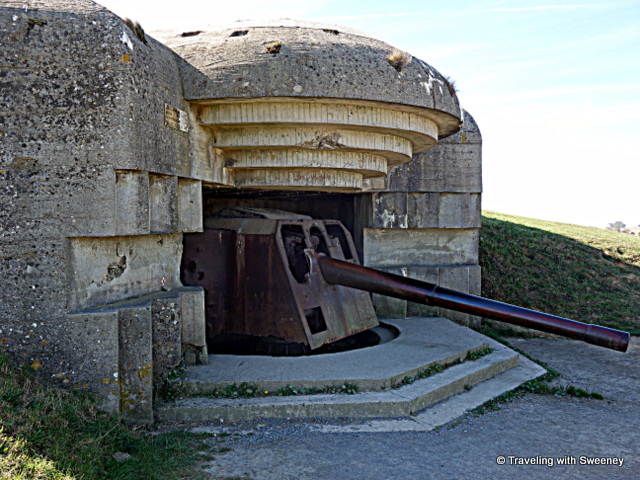
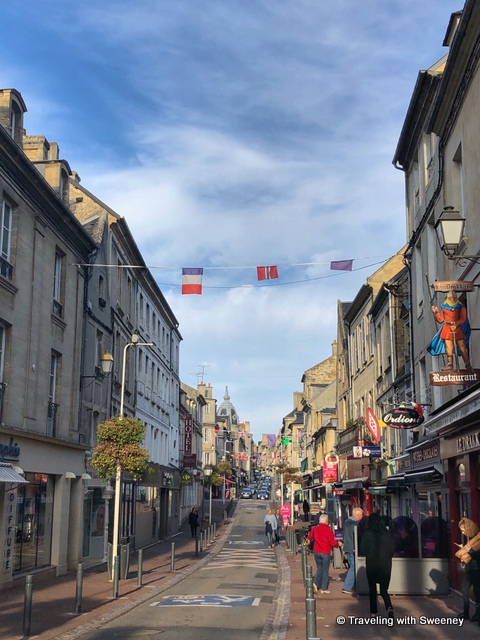
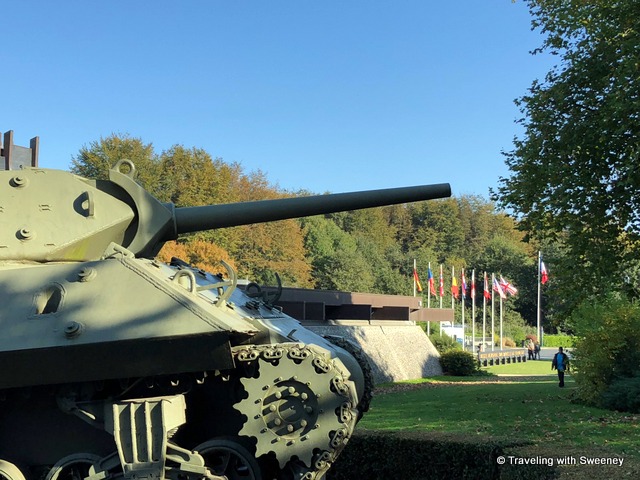
This is a poignant tour that more Americans should do, and know about. My father was one of the U.S. Army 5th Ranger Battalion who was in reserve at Pointe du Hoc on D-Day, then ended up being dropped off at Omaha Beach when the men of the 2nd Rangers ended up taking Pointe du Hoc. Of course where he was landed was the infamous Dog Green sector of Omaha that was immortalized in Saving Private Ryan. To see where those men fought and died, and knowing my Dad was one of them, was too emotional for me. I can’t say more.
Hi Cathy. Thx for this article about Normandy as tribute to Veterans’ Day. It is very moving to see all those unmarked graves.
How touching to visit and see the memorials. Thank you for the stirring photos. We can’t forget wars human cost. My parents are buried in the San Diego Military cemetery. Time to visit.
What a very poignant and touching tour. Small French towns and beautiful scenery are on my list of travel must-sees, but I hadn’t really thought about the war towns and scenery. So much sad history. Must go, and must keep on remembering too. #Boomer Travel Bloggers
Oh no. We were in Paris for a week, after three weeks elsewhere in Europe. We had planned on going to Normandy but dropped it at the last minute because we felt tired already. Now I so regret not seeing all of these in person!
Thanks for sharing your itinerary and wonderful photography. Visiting American cemeteries in Europe is humbling. Great post!
Pingback: 7-Day Normandy and Brittany Itinerary | Traveling with Sweeney
I write thank you cards to our vets who go on the Honor Flights. My husband and I are going on a tour to Normandy, etc and I would like to write a card of thanks to those who died and are buried there. I know they won’t read them but I would like to show my heart-felt thanks to those who fought alongside my dad and uncles. Would this be ok to leave one at the sites we visit?
I know that visiting Normandy will be a very meaningful experience for you and your husband. Thank you for the thoughtful cards you write to vets! I’ve reached out to contacts in Normandy and will get back to you when I get a response.
Vicki – I got the following response from Normandy tourism. Hope it helps!
“Each museum and each military cemeteries have a guest book. So, your readers are free to leave notes in those books while in Normandy at any time”.